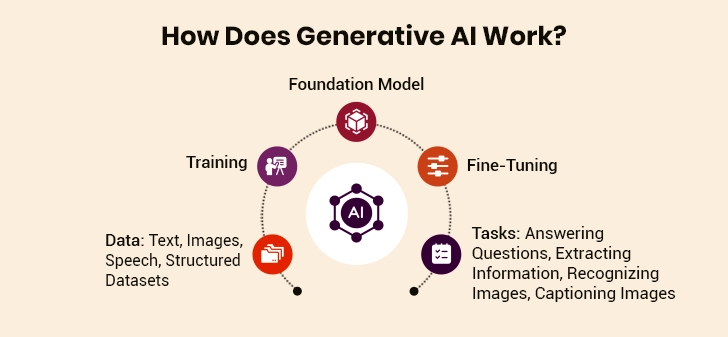Why is generative AI’s massive promise still just potential? It could unlock billions in revenue through specialized virtual assistants, infrastructure products, and developer tools. Yet, few companies see a concrete boost in their earnings from their generative AI projects.
There is a huge disparity between what is possible and what is happening. Despite this, business adoption of generative AI keeps rising. Most business leaders already use this technology or plan to try it soon. The high visibility of tools like ChatGPT has pushed executive leaders to invest more in AI. This glaring gap between enthusiasm and results shows a clear lack of preparedness. Companies need better implementation strategies to realize significant gains in profits.
This blog talks about how IT leaders can use smart strategies and solid execution to make generative AI work for them. Let’s get started.
Table of Contents
Why Should Generative AI Be a Priority Now?
What Foundational Steps Must Precede Development?
How Does Generative AI Development Work?
Which Best Practices Ensure Ethical and Compliant Deployment?
How Does Generative AI Work?
Generative AI represents artificial intelligence that discovers complex patterns in vast training datasets to create new, original content based on its learning. Unlike conventional AI systems that analyze existing data, generative AI produces fresh outputs in the form of text, images, and code.
These systems are built on foundation models with billions of parameters. The parameters are numerical settings in the model’s neural network that store patterns from training data. GPT-3 packs 175 billion parameters, and rumors suggest GPT-4 might contain trillions. When a model gets a prompt, it uses its parameters to decide the most probable output.
The way generative AI processes information differs vastly from human language. It breaks down information into tokens rather than words. This helps models apprehend complex interconnections among data elements.
Modern generative AI systems use these key architectures:
- Transformer Networks: These networks create an attention map that captures relationships between all tokens in text. The map allows models to understand context holistically during content generation. Natural language processing has changed completely because of this non-sequential data processing approach.
- Diffusion Models: These models use a two-step process. Random noise is first added to the training data, then removed to reconstruct the data. Though their training takes longer, diffusion models create the highest-quality outputs and drive systems like Stable Diffusion.
- Variational Autoencoders (VAEs): These networks compress input data while keeping its essence and removing unnecessary details. They work faster than diffusion models but produce less intricate results.
- Generative Adversarial Networks (GANs): Two neural networks compete: one creates content while the other validates its authenticity. This competition drives improvement until generated content closely matches real-life examples.
During training, these models are given large volumes of text (tokens) and asked to make simple predictions, e.g., predict the next word in a sequence.
Models start with poor predictions but improve through a backpropagation algorithm that adjusts the parameters to make correct predictions more likely. After processing trillions of tokens, models excel at predicting what will come next.
Models go through fine-tuning after initial training. Human reviewers evaluate the outputs produced by the model and offer feedback. This guides models toward more accurate, relevant responses.
Why Should Generative AI Be a Priority Now?
Research suggests generative AI could contribute $2.6 trillion to $4.4 trillion yearly to businesses of all sizes. Adopting this technology has now become a necessity for everyone.
1. Competitive Necessity
Business leaders have moved far beyond mere curiosity about generative AI. Most of them are actively piloting or deploying solutions. Data reveals that 89% of executives report their organizations are pushing forward with generative AI projects. This is clearly a dramatic shift. Just last year, only 16% of executives considered this technology a top priority for business transformation. Companies that wait too long to adopt generative AI may fall behind their competitors.
2. Catalyst for Efficiency
Generative AI can help companies work more efficiently. It can automate most of the formulaic tasks today. This automation can increase yearly productivity growth by 0.5-3.4%.
These gains create meaningful competitive advantages. Business departments redirect valuable resources from routine tasks to strategic projects. Organizations accomplish more with fewer resources. The projected returns on investment also appear promising.
These benefits have persuaded most organizations to use generative AI. They’re creating new, increasingly efficient models, algorithms, and applications.
How AI in Healthcare is Augmenting Medical Expertise
3. Innovation Driver
The power of generative AI to propel development makes it a priority for any business. Companies can now deliver customized experiences at unprecedented levels. They can build and test prototypes and build new product lines much faster.
The technology has allowed companies to:
- Reduce the cost of product design through the selection of suitable materials
- Speed up customer trials by creating appropriate user profiles
- Generate sophisticated product designs much faster
Organizations that see generative AI as both a cost-efficiency tool and an innovation engine can scale it beyond isolated functions. This helps them capture value that less strategic competitors cannot.
What Foundational Steps Must Precede Development?
Organizations need to take preparatory measures before they start generative AI development, as these foundations determine their long-term success. An appraisal of technical infrastructure, data capabilities, and business use cases helps them maximize revenue and mitigate risks.
I. Infrastructure Assessment
The complexity of Generative AI models requires powerful cloud GPUs. These processors handle the massive computational workloads needed for training and running these models.
Since models keep getting larger with time, the infrastructure must scale seamlessly to support them. Distributed computing across multiple GPUs allows running gargantuan models that exceed a single system’s capacity. Scalable infrastructure helps your organization move effortlessly from original pilots to enterprise-wide implementations.
II. Data Readiness
Data quality stands as the biggest challenge for successful generative AI implementation. The principle “garbage in, garbage out” matters even more with generative AI systems. Often, low-quality data creates serious problems because flawed input leads to flawed results.
Conventional governance frameworks focused mainly on structured data. These should be updated to accommodate generative AI systems, which handle large quantities of unstructured data.
To comply with regulations, one should:
- Adhere to data privacy rules
- Get consent for using the training data
- Actively track and reduce bias
- Keep records of data sources, training processes, and model decisions
III. Use Case Selection
Successful organizations start with low-risk, high-ROI experiments. Researchers suggest breaking workflows and jobs into discrete tasks when identifying potential use cases.
A use case can be chosen based on its:
- Alignment with business objectives
- Technical feasibility with existing data
- Potential return on investment
- Risk profile and margin for error
Small, focused projects with clear success metrics work best. The right data matters, too. If you have a specific AI use case in mind, review your available data sources. Check if you have the necessary data, if it’s accessible, and if the quality meets your needs. Companies should avoid getting slowed down by technical demonstrations and instead direct their focus toward the broader business effects of AI.
How Does Generative AI Development Work?
Generative AI development turns business problems into working solutions through its many phases.
1. Problem Definition
Start the development process by defining the problem and understanding how the proposed AI solution can solve it. Also, check if the AI project is aligned with your company’s core goals.
Next, conduct a technical check. Can your current hardware and software support the AI project? Additionally, verify processing power and storage capacity. Skipping these crucial steps can result in costly failures.
2. Data Collection and Preprocessing
Generative AI development relies on collecting, cleaning, and transforming data. If the data quality is poor, the model will find it difficult to deliver results, no matter how powerful it is.
The data for a project might come from proprietary repositories, external datasets, or user-generated inputs. Create an exhaustive inventory of all such data sources. Evaluate each source against your AI goals.
At this stage, it is essential to:
- Fix errors in your data
- Remove duplicates
- Fill in the missing details
- Standardize formats
3. Model Selection
This phase involves choosing the right foundation model. The decision must weigh several factors:
- Output quality for your specific task
- Speed and capacity requirements
- Cost constraints
- Data privacy and security needs
Test the model against your unique requirements. This helps you decide whether ready-made models will suffice or if a customized solution is needed.
4. Model Fine-Tuning and Testing
Fine-tuning adjusts the selected model for specific tasks using a smaller, targeted dataset. This improves the model’s accuracy for your business needs.
Testing comes next. It evaluates the model across many areas in addition to accuracy. Teams test the model’s performance on unseen data, error recovery, and possible drift over time. All these steps ensure it works reliably before it is released.
5. Deployment
The model is moved to a live production environment during deployment. At this stage, teams should:
- Build scalable systems to handle real-world usage.
- Connect the model with existing applications.
- Improve security using encryption and access rules.
- Optimize costs and plan for future growth.
6. Monitoring and Improvement
Proper oversight becomes essential once the model has been launched. Keep a track of metrics like:
- Token usage and costs
- Model drift detection
- Response quality and latency
- Model transparency
Set up clear feedback channels with users to improve the model continuously. Most models need regular updates and retraining based on new data and changing business requirements.
| Stage | Objective | Primary Activities |
|---|---|---|
| Problem Definition | Align the project with business goals |
|
| Data Prep | Ensure high-quality training data |
|
| Model Selection | Choose the right model |
|
| Fine-Tuning and Testing | Adjust the model as required |
|
| Deployment | Maintain performance |
|
| Monitoring | Maintain performance |
|
Asset Management Firm Delivered Improved User Experience with a Generative AI Chatbot
Which Best Practices Ensure Ethical and Compliant Deployment?
Organizations must take steps to ensure responsible AI deployment. Successful implementation creates a balance between innovation and safeguards that protect people and society from all possible risks.
I. Bias Mitigation
Generative AI systems tend to pick up biases coded into their training data. These biases can exacerbate existing societal prejudices. IBM’s AI Fairness 360 toolkit is helpful in such situations. This open-source library has techniques to test datasets and models for discriminatory tendencies. It also provides algorithms to remedy these problems.
Businesses should use representative training data that prevents AI from learning harmful biases that are present in unbalanced data. They must also run regular audits to check how the model performs for different user groups. This helps catch hidden biases that appear during development or after launch.
II. Regulatory Alignment
The NIST AI Risk Management Framework offers a structured approach for managing risks related to AI systems. Released in January 2023, this framework helps organizations build trustworthy AI systems.
The EU AI Act groups AI systems by risk levels. High-risk systems must pass thorough assessments before they are put on the market. The act mandates transparency for generative AI solutions. Companies must disclose AI-generated content and publish summaries of copyrighted training data.
III. Human Supervision
AI systems find it difficult to handle human elements such as empathy, which drive decisions in the real world. For this reason, human oversight is still vital. The EU AI Act requires high-risk AI systems to work with human supervision. Human operators must be able to understand the constraints of these systems, interpret their outputs correctly, and override their decisions when circumstances demand.
IV. Intellectual Property Safeguards
Generative AI can sometimes produce work that looks similar to the copyrighted material it was trained on. This can raise intellectual property concerns. To avoid these issues, organizations must develop clear policies that cover both input data and generated outputs.
Teams should use AI tools trained only on data that is licensed or in the public domain. This helps them avoid copyright violations. They should also document the role of humans in the creation process and establish clear agreements about copyright ownership in computer-generated works.
The Final Word
Generative AI has proven transformative for organizations that implement it thoughtfully, rather than treating it as just another trend. Many companies show enthusiasm but struggle to get real results. IT leaders who take a methodical approach to generative AI development capture substantial value.
Generative AI offers remarkable potential. However, results demand careful strategy, smart implementation, and constant refinement. Companies that adopt this technology while handling its complexities will prosper in an AI-driven business world.







